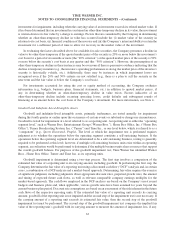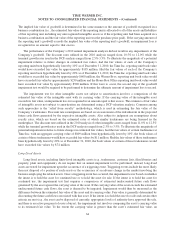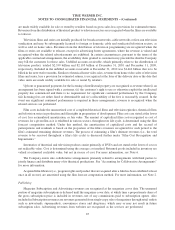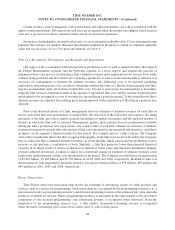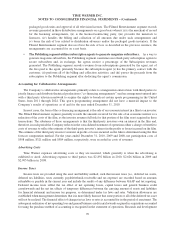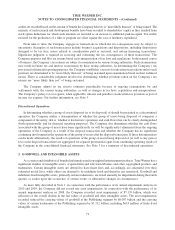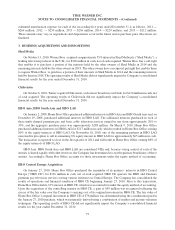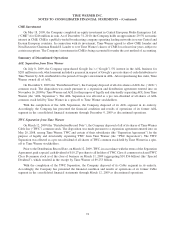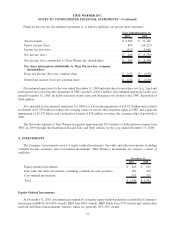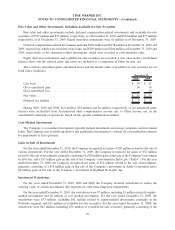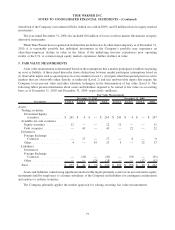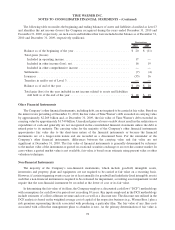Time Magazine 2010 Annual Report Download - page 81
Download and view the complete annual report
Please find page 81 of the 2010 Time Magazine annual report below. You can navigate through the pages in the report by either clicking on the pages listed below, or by using the keyword search tool below to find specific information within the annual report.Multiple-Element Transactions
In the normal course of business, the Company enters into transactions, referred to as multiple-element
transactions, that involve making judgments about allocating consideration to the various elements. While the more
common type of multiple-element transactions encountered by the Company involve the sale or purchase of
multiple products or services (e.g., licensing multiple film titles in a single arrangement), multiple element
transactions can also involve contemporaneous purchase and sales transactions, the settlement of an outstanding
dispute contemporaneous with the purchase of a product or service, as well as investing in an investee while at the
same time entering into an operating agreement. In accounting for multiple-element transactions, judgment must be
exercised in determining the fair value of the different elements in a bundled transaction. The judgments made in
determining fair value in such arrangements impact the amount of revenues, expenses and net income recognized
over the term of the contract, as well as the period in which they are recognized.
If the Company has evidence of fair value for each deliverable in a multiple-element transaction, then it
accounts for each deliverable in the transaction separately, based on the relevant accounting policies. However, if
the Company is unable to determine fair value for one or more elements of the transaction, the transaction is
accounted for as one unit of accounting and is recorded as revenue, a reduction of revenue, costs or a reduction of
costs, as applicable. The timing of the recognition of revenues for the unit of account will depend on the nature of
the deliverables comprising the unit of accounting as well as the conditions for revenue recognition, to the extent
applicable.
In determining the fair value of the respective elements, the Company refers to quoted market prices (where
available), independent appraisals (where available), historical transactions or comparable cash transactions. Other
indicators of fair value include the existence of price protection in the form of “most-favored-nation” clauses or
similar contractual provisions and individual elements whose values are dependent on future performance (and
based on independent factors). Further, in such transactions, evidence of fair value for one element of a transaction
may provide support that value was not transferred from one element in a transaction to another element in a
transaction.
Gross versus Net Revenue Recognition
In the normal course of business, the Company acts as or uses an intermediary or agent in executing transactions
with third parties. In connection with these arrangements, the Company must determine whether to report revenue
based on the gross amount billed to the ultimate customer or on the net amount received from the customer after
commissions and other payments to third parties. To the extent revenues are recorded on a gross basis, any
commissions or other payments to third parties are recorded as expense so that the net amount (gross revenues less
expense) is reflected in Operating Income. Accordingly, the impact on Operating Income is the same whether the
Company records revenue on a gross or net basis.
The determination of whether revenue should be reported gross or net is based on an assessment of whether the
Company is acting as the principal or an agent in the transaction. If the Company is acting as a principal in a
transaction, the Company reports revenue on a gross basis. If the Company is acting as an agent in a transaction, the
Company reports revenue on a net basis. The determination of whether the Company is acting as a principal or an
agent in a transaction involves judgment and is based on an evaluation of the terms of an arrangement. The
Company serves as the principal in transactions in which it has substantial risks and rewards of ownership.
The following are examples of arrangements where the Company is an intermediary or uses an intermediary:
•The Filmed Entertainment segment provides distribution services to third-party companies. The
Filmed Entertainment segment may provide distribution services for an independent third-party company
in the worldwide theatrical, home video, television and/or videogame sectors. The independent third-party
company may retain final approval over the distribution, marketing, advertising and publicity for each film
or videogame in all media, including the timing and extent of the releases, the pricing and packaging of
69
TIME WARNER INC.
NOTES TO CONSOLIDATED FINANCIAL STATEMENTS – (Continued)






